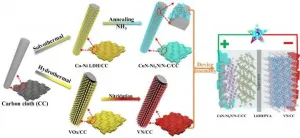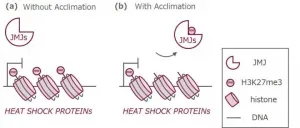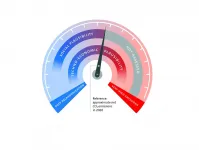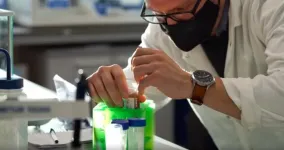Bacteria hijack latent phage of competitor
Biochemists discover highly selective phage activation based on signal molecule
2021-06-10
(Press-News.org) This targeted control of phages provides entirely new biotechnological and therapeutic approaches, e.g. for phage therapies. The results produced in the context of an ERC grant have been published in the Journal of the American Chemical Society.
The human body and its microbiota harbour a large amount of phages. These infect bacteria as virus particles to ensure their own survival. One of their strategies is to integrate into the bacterial genome and multiply via bacterial cell division. However, external signal molecules can trigger the phages' sudden awakening from their dormant stage. Once activated, they destroy their host, the bacterium, and thus release their newly produced viral particles. With a prestigious ERC Consolidator Grant of the European Research Council, Thomas Böttcher investigates the switch from the sleeping (lysogenic) to the activated (lytic) lifestyle of phages.
Warfare between microbes
"We already know that phages decisively influence the population dynamics of bacteria and that microorganisms compete by using chemical weapons," says Thomas Böttcher, Professor of Microbial Biochemistry of the Faculty of Chemistry and the Centre of Microbiology and Environmental Systems Science. "We now wanted to investigate whether, in the complex microbial ecosystems, there are also microbes that specifically activate phages in order to use them against their competitors."
Indeed, the researchers could show that the bacterium Pseudomonas aeruginosa produces large amounts of a signal molecule that triggers the conversion of a phage, residing in a strain of the species Staphylococcus aureus, from a quiet companion into a deadly parasite.
Highly selective phage activation
"We were completely surprised to find that the chemical compound pyocyanin, which we were able to isolate and synthesise, only specifically activated one of several phages of Staphylococcus aureus. Pyocyanin is therefore a highly selective agent," says co-author Magdalena Jancheva.
The drug mitomycin C induces DNA damage in bacterial cells and causes phages to leave their dying host, but according to Thomas Böttcher, "it activates all phages in the bacteria in a non-selective manner". The researchers also observed that pyocyanin releases even more phages in Staphylococcus aureus than mitomycin C, pyocyanin therefore had an "remarkably strong effect".
Discovery provides new perspectives
The bacterial species Pseudomonas aeruginosa and Staphylococcus aureus occupy the same ecological niche in the human body. As pathogens, they frequently occur in the lungs of patients with cystic fibrosis, a congenital metabolic disease. Staphylococcus bacteria dominate at a young age, while Pseudomonas bacteria become more prevalent with increasing age.
The current study demonstrates the efficiency of activation of latent phages by chemical signaling agents in the battle for space and resources between bacterial strains. It provides the first evidence that chemical signaling agents can exhibit selectivity for specific phages in a polylysogenic bacterial strain. Here, the activated phage (phiMBL3) revealed a previously unknown molecular switch through which the signaling agent acts.
"Certain signaling molecules could make it possible to combat pathogens via phage activation - they could thus be used to initiate internal phage therapy," Thomas Böttcher states. At the same time, the phages' molecular switches, which selectively trigger the production of viral particles through a signaling molecule such as pyocyanin, could also serve as a new tool for biotechnology or synthetic biology. "Our findings open up a wide field in which we want to move forward", the researchers conclude.
INFORMATION:
Publication in "JACS - Journal of the American Chemical Society":
A Metabolite of Pseudomonas Triggers Prophage-Selective Lysogenic to Lytic Conversion in Staphylococcus aureus. Magdalena Jancheva & Thomas Böttcher, in: Journal of the American Chemical Society 2021, DOI: https://doi.org/10.1021/jacs.1c01275
[Attachments] See images for this press release:
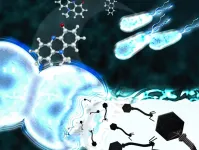
ELSE PRESS RELEASES FROM THIS DATE:
2021-06-10
Imagine you're a fisherman living by a lake with a rowboat. Every day, you row out on the calm waters and life is good. But then your family grows, and you need more fish, so you go to the nearby river. Then, you realize you go farther and faster on the river. You can't take your little rowboat out there - it's not built for those currents. So, you learn everything you can about how rivers work and build a better boat. Life is good again...until you realize you need to go farther still, out on the ocean. But ocean rules are nothing like river rules. Now you have to learn how ocean currents work, and then ...
2021-06-10
DARIEN, IL - Findings from a recent study show that patients with untreated, moderate to severe obstructive sleep apnea had a higher risk of experiencing a cardiovascular event, but the risk of incident heart problems was decreased in those who used CPAP therapy.
Results show that people with moderate to severe sleep apnea and no record of CPAP use were 71% more likely than those without sleep apnea to experience incident myocardial infarction, stroke, unstable angina, heart failure or cardiovascular death. Compared with the risk of heart problems in people with untreated sleep apnea, the risk of experiencing a cardiovascular event was 32% lower ...
2021-06-10
ITHACA, N.Y. - The Noceto Vasca Votiva is a unique wood structure that was unearthed on a small hill in northern Italy in 2005. Built primarily of oak and slightly larger than a backyard swimming pool, the exact purpose of the in-ground structure has remained a mystery, as has the date of its construction. Italian researchers estimated its origins go back to the late Middle Bronze Age, sometime between 1600 and 1300 B.C.
While that gap might not seem huge, in archeological terms it's like comparing the culture that invented the steam engine with the one that produced the iPad.
A Cornell University team led by Sturt Manning, Distinguished ...
2021-06-10
Fast radio bursts, or FRBs, blaze for a few milliseconds before vanishing without a trace. Their origins are unknown, and their appearance is unpredictable. In the decade following their discovery in 2007, only 140 FRBs had been seen. Now, thanks to the launch of a large stationary telescope in the interior of British Columbia in 2018, the number of new FRBs detected has almost quadrupled - for a total of 535. Moreover, the Canadian Hydrogen Intensity Mapping Experiment (CHIME/FRB), a McGill-led inter-university collaboration, has put together the first CHIME/FRB catalogue, which will be presented this week at the American Astronomical Society Meeting.
CHIME is unique in that ...
2021-06-10
Recently, a research team led by Prof. ZHAO Bangchuan from the Institute of Solid Materials of the Hefei Institutes of Physical Science (HFIPS) synthesized 3D porous honeycomb-like CoN-Ni3N/N-C nanosheets and vanadium nitride (VN) nanobelt arrays via in-situ growth method, respectively, and constructed a high-energy-density flexible supercapacitor device. The result has been published in Advanced Functional Materials.
Transition metal nitrides (TMNs) are potential electrode materials for high-performance energy storage devices, but the structural instability severely hinders their application. Therefore ...
2021-06-10
Ikoma, Japan - "If you can't stand the heat, get out of the kitchen," as the old saying goes. But for organisms that can't leave the proverbial kitchen when things get too hot, there's another way: researchers from Japan have discovered that plants can gain heat tolerance to better adapt to future heat stress, thanks to a particular mechanism for heat stress 'memory'.
In a study published in Nature Communications, researchers from Nara Institute of Science and Technology have revealed that a family of proteins that control small heat shock genes enables plants to 'remember' how to deal with heat stress.
Climate change, especially global warming, is a growing threat to agriculture ...
2021-06-10
Prostate cancer is the most common form of cancer among Canadian men and the third leading cause of cancer death. Abdominal obesity appears to be associated with a greater risk of developing aggressive prostate cancer. This link was demonstrated in a END ...
2021-06-10
Generally, physics and financial systems are not easily associated in people's minds. Yet, principles and techniques originating from physics can be very effective in describing the processes taking place on financial markets. Modeling financial systems as networks can greatly enhance our understanding of phenomena that are relevant not only to researchers in economics and other disciplines, but also to ordinary citizens, public agencies and governments. And the theory of Complex Networks represents a powerful framework for studying how shocks propagate in financial systems, identifying early-warning signals of forthcoming crises, and reconstructing ...
2021-06-10
Today the Hamburg-based Cluster of Excellence "Climate, Climatic Change, and Society" (CLICCS) publishes a new, essential study on climate futures. The study represents the first systematic attempt to investigate whether a climate future with net-zero carbon emissions is not only possible but also plausible. The authors examine plausibility from a technical-economic perspective, but also with regard to the societal changes necessary for such a future. They conclude that deep decarbonization by 2050 is currently not plausible - the current efforts to bring about societal transformation need to be far more ambitious.
The European Union is now increasing the ambition of its climate goals, and the German Federal Constitutional Court has recently committed Germany ...
2021-06-10
Researchers have created a plant-based, sustainable, scalable material that could replace single-use plastics in many consumer products.
The researchers, from the University of Cambridge, created a polymer film by mimicking the properties of spider silk, one of the strongest materials in nature. The new material is as strong as many common plastics in use today and could replace plastic in many common household products.
The material was created using a new approach for assembling plant proteins into materials which mimic silk on a molecular level. The energy-efficient method, which uses sustainable ingredients, results in a plastic-like free-standing film, which can be made at industrial ...
LAST 30 PRESS RELEASES:
[Press-News.org] Bacteria hijack latent phage of competitor
Biochemists discover highly selective phage activation based on signal molecule

